Dan Eckstein May 10, 2015
Posted by Geoffrey Hiller in India.Tags: India
comments closed
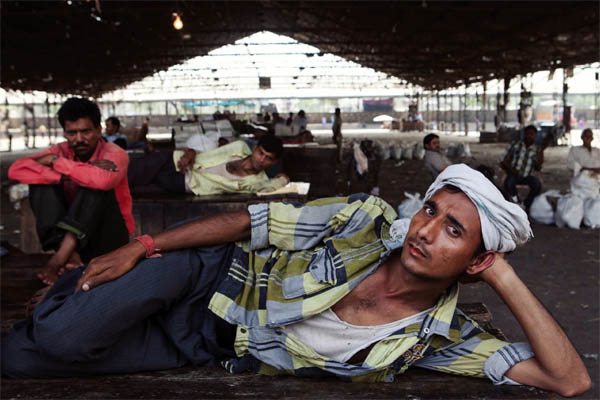
Azadpur Market. Delhi, India 2013
Dan Eckstein (b.1980, United States) spent four years studying photography at Skidmore College in the foothills of the Adirondacks. After graduation, he moved to New York City to assist renowned photographer Steve McCurry. He later worked with Magnum photographer Bruno Barbey in Paris. Dan’s work has been widely published and exhibited and he was included in The Collector’s Guide to Emerging Art Photography. He was recently awarded Best Photo Essay in PDN’s World In Focus photo contest and included in American Photography 30. For Dan’s latest project, he drove 10,000km over the course of three years documenting the trucks, drivers and roadside culture of India. He is based in Los Angeles and Brooklyn, NY.
About the Photograph:
“This photo was taken in Delhi’s Azadpur market which is the biggest wholesale fruit and vegetable market in Asia. The market is filled with brightly decorated trucks bringing goods to be bought and sold from though-out India and I was there photographing them for my book project, Horn Please: The Decorated Trucks of India. Most of the action at these markets happens in the morning and I was there towards the end of the day so the workers were cleaning up and this guy was having a rest after a hard day’s work.”
Kevin WY Lee October 2, 2014
Posted by Geoffrey Hiller in India.Tags: India
comments closed
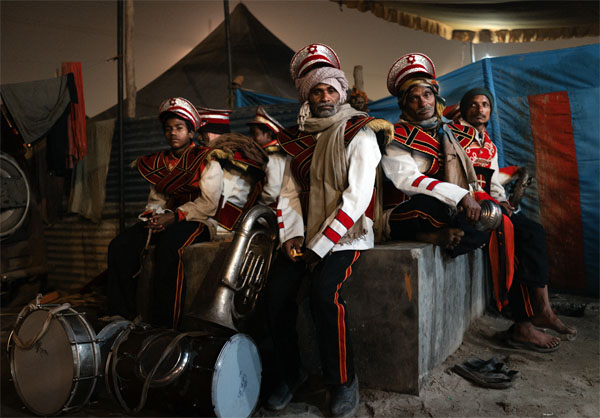
Maha Kumbh Mela, in Allahabad, India 2013
Kevin WY Lee (b. 1973, Fiji) is a photographer and creative director based in Singapore. In 2010, he founded Invisible Photographer Asia (IPA), an organization which has since grown to become a leading, influential platform for Photography & Visual Arts in Asia. His work has been featured in CNN, Straits Times, Discovery Magazine, GE11 Book and the Twentyfifteen Project. Aside from his own practice, Kevin is also active in producing, curation and jury duties for various awards and programs. Kevin is a Design graduate of the College Of Fine Arts, University Of New South Wales, Australia.
About the Photograph:
“This photograph was made in the wee hours before the dawn of 10th February 2013, the holiest day of the Maha Kumbh Mela, in Allahabad, India. Maha Kumbh Mela is a pilgrimage to the River Ganges that happens once every 144 years. That day saw the largest human gathering on a single day. Over 30 million devotees and holy men had gathered to take a holy bath at the Sangam banks. These marching band members and many other common folks I encountered in Allahabad looked like they had waited an eternity for this day of reckoning. After I made this picture and more, I waded through an endless sea of humanity back to camp. It was an experience never to be forgotten. The day after, I celebrated my mid-life birthday.”
Anna Maria Antoinette D’Addario April 21, 2014
Posted by Geoffrey Hiller in India.Tags: India
comments closed
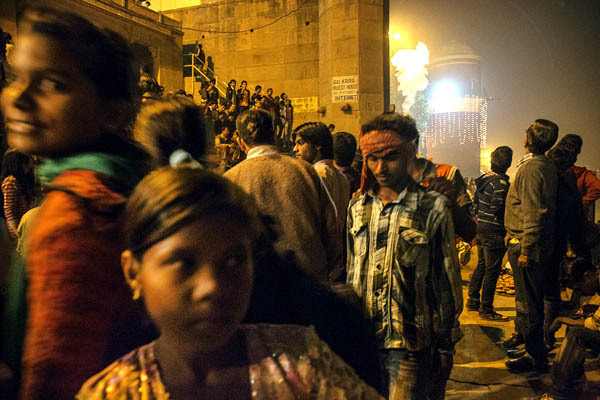
Devotees flock to the ghats on the night of the full moon of Kartika. Varanasi, India 2013
Anna Maria Antoinette D’Addario (b. 1981 Australia) moved to Rome in 2005 where she studied photography at the Institute ISFCI. In 2007 Anna was awarded a MAE Scholarship grant from the Italian Minister of Foreign Affairs for her photographic studies. For the past three years she has been assisting photographer Stephen Dupont in Australia and in 2012 was appointed Assistant Director of the Sydney based Reportage Festival, for which she curated various exhibitions in 2013. Anna’s work has been published in Vogue UK, The Guardian UK and Art Rocker Magazine. She is currently working on a series of long-term projects primarily focused in India and The Philippines. Aligned with Getty Images this year she will soon be contributing to their editorial coverage in Asia.
About the Photograph:
“Every year on the full moon of Kartika, November to December, Dev Deepavali is celebrated. The Festival has been called the ‘Diwali of the Gods’ and it is believed on this night that the gods come down to bathe in the holy Ganges, India’s sacred river that flows through the heart of the city. Thousands of devotees flock to the ghats of the city to attend Ganga Aarti and watch the river glow with innumerable (Diyas) earthern oil lamp candles, electric lights, fireworks and lanterns.”
“Varanasi also known as Kashi, Benares, The City of Light, one could say is the axis on which all the mythology, the darkness, the light and all the truth and beauty of India rotates. One of the oldest living cities in the world and the holiest in India, it has been a continuous source of inspiration for philosophers, musicians, poets, artists and photographers for centuries and played an essential part in the development of Buddhism. This photograph is from a series of images from the 2013 Dev Deepawali and a part of a larger continuing project in greater India focusing on myth and identity.”
Marion Gambin January 30, 2014
Posted by Geoffrey Hiller in India, Kashmir.Tags: India, Kashmir
comments closed
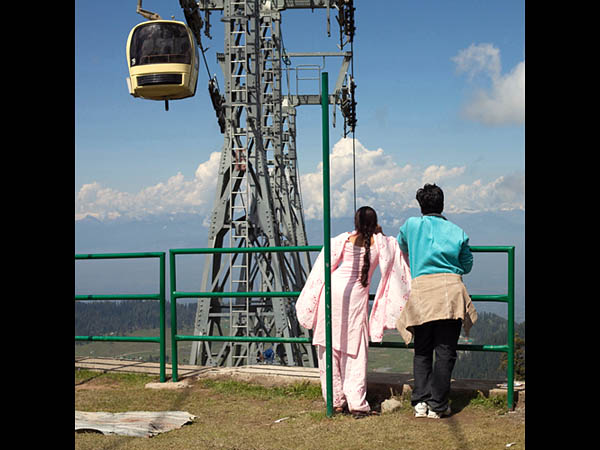
Gulmarg, Kashmir, India 2010
Marion Gambin (b.1985, France) obtained her undergraduate degree (BFA) in the Beaux-Arts of Toulouse and joined the photography section of the ENS Louis-Lumière from which she graduated with a Masters in Photography in June 2011. She has worked on assignment for Libération, Le Monde, Causette and Internazionale. Her personal work is close to the new documentary photography, with a special emphasis on portrait. It has been showed in the Phnom Penh photo festival and the Pluie d’Images festival at Brest, France. Marion currently lives in Paris.
About the Photograph:
“This photograph shows the view of Kongdoori, in Gulmarg at a small ski station in Indian Kashmir. Situated at 8,500 feet, this town claims to have the ‘highest ski lift in the world. This village scene is popular with Western tourists who like winter sports, and with privileged Indians during summer. Like the former British colonials, the Indian vacationers come to enjoy the cool weather and picturesque setting. Generally these Indian tourists come to Gulmarg as if they were going to Disneyland, staying just a few days to ride the lift, touch the snow and go sledding. The young couple in the photograph is here on honeymoon.”
“The area is heavily patrolled by the military, with several checkpoints at the entrance to the town. The region has been in conflict since the partition of India from Pakistan at the end of the colonial era 60 years ago, with both countries still claiming rights to the territory of Kashmir. This trouble explains why the construction of the ski lift took such a long time, more than 15 years, interrupted by violence, including the kidnapping of French engineers. But today Gulmarg seems perfectly peaceful, since the Indian government has made a special effort to ensure the security of the area.”
Robert Nickelsberg June 10, 2013
Posted by Geoffrey Hiller in India, Kashmir.Tags: India, Kashmir
comments closed
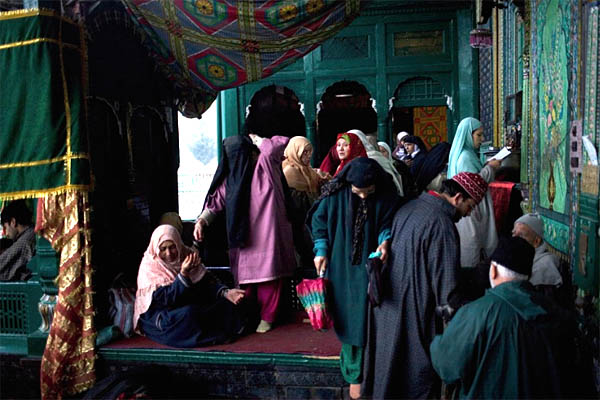
Shah-i-Hamadan shrine in Srinagar, Kashmir 2010
Robert Nickelsberg (b. 1950, United States) has been TIME magazine contract photographer for 25 years based in New Delhi from 1988 to 2000. During that time, he documented conflicts in Kashmir, Iraq, Sri Lanka, India and Afghanistan. He was one of the few photographers who had first hand exposure to the early days of the rise of fundamentalist groups in the Afghanistan-Pakistan tribal areas and al-Qaeda, and his work provides a unique up close view of the Soviet withdrawal, the rise of the Taliban and the invasion by the U.S. Robert moved to New York in 2000 and continues to travel overseas – reporting on the invasion of Afghanistan in 2001 and Iraq in 2003 – and focus on chronicling the devastating psychological effects of war in Kashmir. In 2008, he was awarded grants from the Dart Center for Journalism and Trauma, and from the South Asia Journalists Association to document and report on post-traumatic stress disorder in Kashmir after 20 years of insurgency. He serves on the advisory board of the Kashmir Initiative at the Carr Center for Human Rights Policy at Harvard University.
About the Photograph:
“I’ve been visiting the Shah-i-Hamadan mosque for over two decades. It’s one of a series of historic shrines that lace Srinagar’s old city, built with colorful paper mache artwork skillfully placed throughout the building. Regardless of when you visit the shrine, a special peacefulness prevails whether it’s during the uncrowded early morning or mid-afternoon hours or during prayer time when the mosque’s floors are usually filled. The photograph was taken of the women’s section at the end of Friday’s mid-day Jumma prayers when women linger to recite prayers from the Koran or greet their neighbors before walking home. It’s an island of tranquility, where Sufi spirituality serves as a healing mechanism for a population effected by chronic violence and trauma. Not only do the bereaved find comfort and refuge here, but so do occasional travelers.”
“The wooden shrine was the first mosque built in Kashmir in 1395 by the Persian saint Mir Sayed Ali Hamadani. Many Kashmiri civilians suffering from Post Traumatic Stress Disorder seek refuge in prayer and song (as well as attending medical clinics and hospitals). The numerous shrines in Kashmir provide a peaceful sanctuary to a population suffering from more than twenty-years of violence between Kashmiri Muslims, Islamic militants and the Indian Army. More than 70,000 civilians have died in the fighting beginning in 1989.”
Joshua Cogan April 25, 2013
Posted by Geoffrey Hiller in India.Tags: India
comments closed
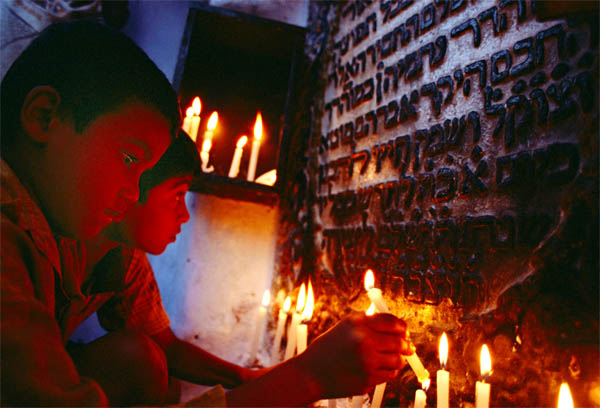
Jewish Graveyard in Cochin, Kerala State, India 2011
Joshua Cogan (b. 1984, United States) is a photographer and anthropologist whose work focuses on documenting vanishing cultures, and those in transition. He has also used technology and traditional storytelling for exploring social issues with photography and new media. In addition to his personal work on Diaspora Judaism in India, Ethiopia and Israel, Joshua has pioneered a number of innovative projects with ad agencies and NGO’s alike. He has won an Emmy in New Approaches to Storytelling for his collaboration with the Pulitzer Center on Crisis Reporting; Live Hope Love, a revelatory look at the silenced voices of HIV-positive Jamaicans enduring the stigmas of their society. His work has been published in the New Yorker, VQR, GQ, Washington Post, and the New York Times among others.
About the Photograph:
“Sometimes there is a experience that changes the whole story, and allows you to understand the purpose of the story you might be “trying” to tell. The picture is from Cochin, India in the state of Kerala. I had gone there to explore the community of Jews that had settled there as spice traders around the time of King Solomon. The members of the community had become quite small in number and I was struggling with how to tell the story of the remaining members and the impact the community had on the area. I began to look for remnants of material culture, and I found them. Abandoned Synagogues, grown over Mikvehs and old pieces of Judaica scattered about curio shops. It was at the Jewish Graveyard that I met four young men playing cards along the wall. They took an interest in me, and began to ask me questions about the project. I told them what I was up to and they assured me that they had something interesting to show me. It was Friday night, and I had been desperate to spend a sabbath with the Jewish Community, and spent most of the day asking them if there would be the required number of Jew’s for a service in the synagogue that night. Often it would require travelers and tourists to fulfill the needed ten, and it seemed to me that this was a very important part of the story.”
“I told the young men I would come with them, but only if the there would be no service that night. I ran back to the shul and saw from the dim lights that indeed there would be no service. And so I wandered back to where the men were playing and they led me to a grave that was far outside the walls and inside one of the chawl villages. Once there I saw this grave, it had Hebrew script but had essentially been “Hindu-ized” painted with bright colors, a stupa added to the top, and candle burnish and marigolds covered it. This was different than the way Jewish graves are generally treated and I immediately was fascinated by what I was observing, I asked my guides, but they could provide little context. It was then the these young men, of both Hindu and Muslim faith came over to begin lighting candles. When I asked them why…the simply replied “Shabbat”. About a week later I took an Israeli friend to translate that writing on the grave for me. It was a holy man named Avram Motah, a Kabbalist from somewhere in the middle east that had traveled to Cochin in the 16th century. It was revealed that he was considered such a pious man, that he has become a symbol to all faith communities of the island.”
Srinivas Kuruganti March 18, 2013
Posted by Geoffrey Hiller in India.Tags: India
comments closed

Toxic site, Hyderabad, India 2008
Srinivas Kuruganti (b.1967, United States) is a photographer of Indian origin. He has have photographed the daily lives of manual laborers, from the ship-breaking yards of Bombay to the coal mining villages of Dhanbad. His most recent project looks at mining in the forests and fertile lands of Orissa. Srinivas was awarded a South Asian Journalist Association fellowship in 2008 for his work on industrial pollution in Gujarat and Andhra. He is also a founding member of ASA Collective that curates monthly slideshow projections of emerging photographers in London.
About the Photograph:
“Patacheru is in the southern Indian city of Hyderabad. It’s a major industrial hub where hundreds of factories manufacturing bulk drugs, pesticides, dyes and fertilizers dump their effluents into the streams. The streams here are considered one of the most toxic in the world. I was near a site where a steel rolling mill dumps their waste in and around communities that live in the industrial estates. The people in these communities scavenge for the iron shavings in the waste using massive magnets which they roll over the waste. They separate the shavings and small pieces of metal by size and resell back to the steel mills. The boy and his sister were standing in front of a truck that had just arrived and were in the process of dumping their waste when this photo was taken.”
Massimiliano Clausi October 19, 2012
Posted by Geoffrey Hiller in India.Tags: India
comments closed
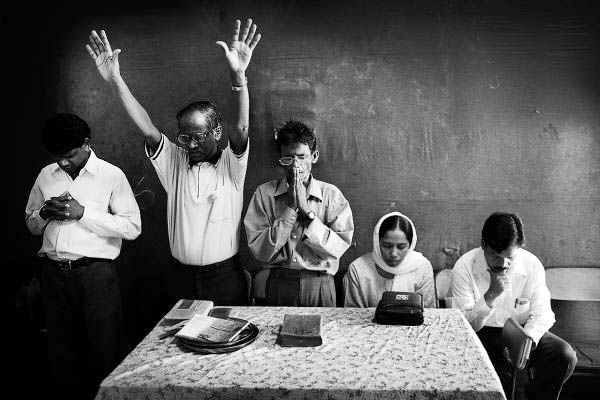
Christian community in Orissa, India 2008
Massimiliano Clausi (b.1979, Italy) is a freelance photojournalist represented by Laif agency. He attended the Danish School of Journalism in 2006 and the same year he was awarded the Canon Young Photographers Scholarship. Since then Massimiliano’s work has been published in TIME, Newsweek and Courier International. He has also partnered with Action Aid, Terre Des Hommes, Amnesty International and UNICEF in promoting their campaigns and raising awareness around human rights issues. He has been a finalist for the Anthropographia Award and a nominated photographer at UNICEF POY in 2011. Massimiliano is based in Genoa and Milan.
About the Photograph:
“This photo was taken in Bhubaneshwar, in the state of Orissa, India, in 2008. I was covering the aftermath of a violent onslaught on the local Christian community by the radical Hindus. I had already visited the affected villages, witnessing the destruction they left behind. The broken houses, the burnt churches and obliterated huts of the poor. I had also listened to the many accounts of rape, murders and miraculous escapes by shocked displaced families. Finally I came to this small refugee camp in the capital, Bhubaneshwar, where a few Lutheran families had been brought in the first days of the assault. Mass was being said in a small classroom of a primary school building that was turned into a dormitory. No one really took notice when I stepped into the room, they were so deeply absorbed in prayer. The audience were sitting on the bare floor and I walked towards the very middle of the room were I stood standing. That was the time when the man on the left side of the picture raised his hands to the sky as if pleading for help from above. I took the picture and thought bitterly that nobody had been listening so far.”
Sanjit Das June 10, 2011
Posted by Geoffrey Hiller in India.Tags: India
comments closed
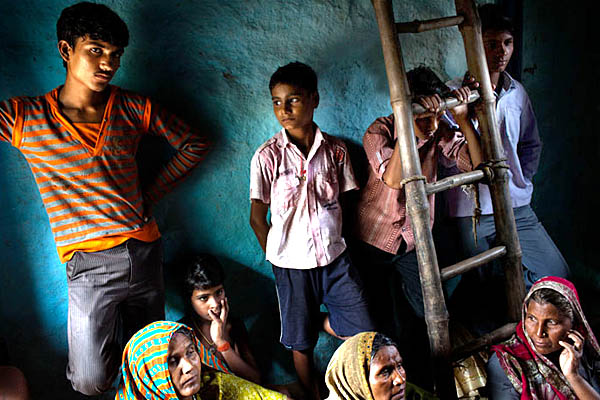
Uttar Pradesh, India 2010
Sanjit Das (b. 1976. India) is a self-taught photographer living between New Delhi and Kuala Lumpur. His photography attempts to document the country’s rapid transformation from rural economy to global superpower, with a focus on the people – especially women and children – who are living through the change. His work is published internationally in, amongst others, Atlantic, Businessweek, Der Spiegel, Le Monde, Wall Street Journal, NYT, Newsweek, TIME. In 2007, Sanjit was featured in a book showcasing contemporary Indian artists, ‘Made by Indians’ published by Gallerie Enrico Navarra. Sanjit is represented by Panos Pictures Agency.
About the Photograph:
“I made this picture while working on a project about insufficient health services provided to the poor in rural India. As soon as we arrived, the villagers gathered to discuss their problems and wanted us to take up the issues to the government officials. I pushed myself against the wall and quietly stood there, waiting for the right moment. The picture in front of me was not only beautiful but miserable. The frame and the bright colors through my viewfinder were beautiful, but the content in front of me was a sharp reminder of a class based society that India is struggling to get rid of- a slice of which one sees here where the women from the lower caste sits on the floor while the upper caste boys stand and stare in the background doing nothing. While claiming to be the fastest growing economy in the world with a seven percent growth rate, India, ironically is struggling to answer that dilemma.”
Arindam Mukherjee May 9, 2011
Posted by Geoffrey Hiller in India.Tags: India
comments closed
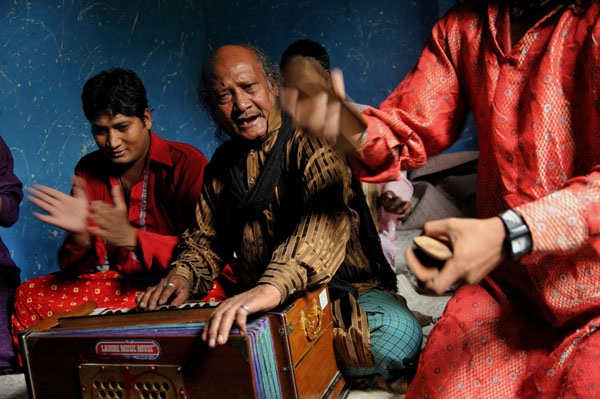
Bhagawan Das, New Delhi, India 2009
Arindam Mukherjee (b.1974, India) is a freelance photojournalist based in Kolkata. He began as an advertising photographer but from the very beginning was more interested in street photography; which later brought him to photojournalism. He has worked with The Times of India and as the chief photographer and assignment director for EyePress photo agency based in Hong Kong. His photographs have been published in: Le Figaro, Stern, Der Spiegel, The Sunday Telegraph, Le Monde, Liberation, Le point, De Volkskrant, Forbes, Traveler Magazine (UK), Marie Claire among others. His awards include: National Media Fellowship in 2003 for his work on India coal miners and the B. Bangoor Endowment Fellowship for his work on Indian Sex workers in 2006. Arindam is represented by Sipa Press , Landov Llc and OTN Reportages.
About the Photograph:
“This picture is a part of a story called Alley of Magic in the Kathputli colony, a slum in New Delhi. Though underdeveloped and overpopulated like any other Indian slums, Kathputli colony is different. All its residents are traditional folk artists and magicians. Some of them have traveled throughout the world to perform in concerts and festivals. A few artists in this disadvantaged community have enough money to move out to a better place with better living conditions but don’t want to. They feel that this slum is a part of their identity. The children of the slum community also want to carry forward their lineage as artists. One of the main things that separate the colony residents from dwellers of other slums is their emotional attachment and dedication towards their art form. I was traveling through one of the narrow alleys inside the slum and I heard a song coming from one of the small houses. After going inside I found singer Bhagawan Das and his group practicing. They were friendly people and gladly accepted my intrusion. I stayed for more than three hours listening to the songs, spell bound.”
Geoffrey Hiller December 17, 2010
Posted by Geoffrey Hiller in India.Tags: India
comments closed
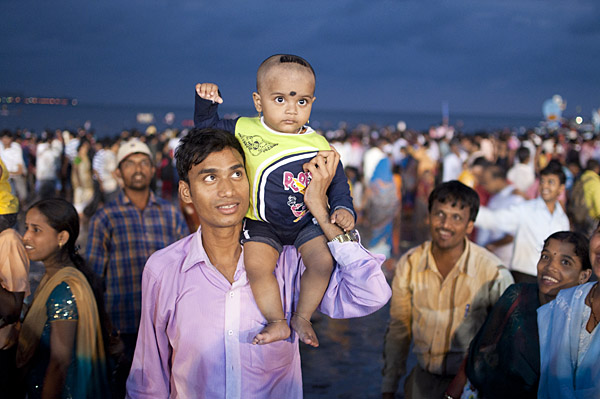
Lord Ganesh Celebration, Mumbai, India 2010
Geoffrey Hiller: Happy holidays from Verve Photo. The next post will be on January 10th. I’ve been busy editing work from India and Bangladesh. In the four months of the trip, unlike my usual habit, I didn’t begin editing until getting back to Portland two weeks ago. It feels like the days when I had to wait to get the film developed and make contact sheets. I like the distance that process provides. By the way, Verve Photo is fast approaching the three-year anniversary mark. In that time we have showcased the work of 500 photographers. It’s exciting to anticipate the New Year and more great discoveries!
About the Photograph:
“I shot this in Mumbai as the sun was going down, before the all-night party for the Hindu Festival of Ganesh Chaturthi. The festival celebrates Lord Ganesh, the Hindu deity who takes the form of an elephant and presides over new beginnings. On the tenth and last day of colorful displays and parades, more then 200,000 statues were immersed in the water at Chowpatty Beach. The frenetic crowds reminded me of Carnival in Rio, minus the nudity. The celebration begins with the installation of giant elaborately crafted statutes of Ganesha in homes and on podiums in the streets. On this last day, the statues are carried through the streets, accompanied by singing and dancing, and then immersed in the ocean. The statues were as tall as 40 feet, but what was most impressive were the groups of people chanting prayers and carrying their own smaller replicas of Ganesh.”
Theodore Kaye October 8, 2010
Posted by Geoffrey Hiller in India.Tags: India
comments closed
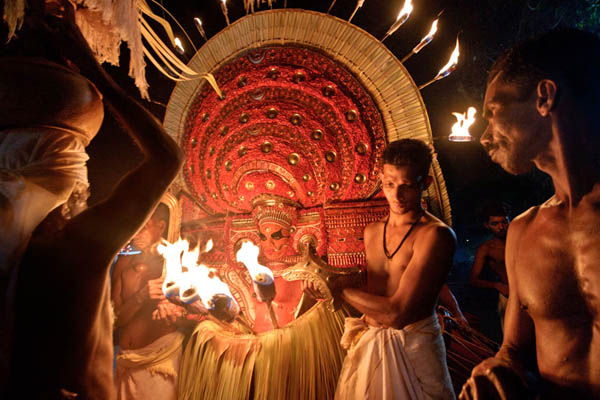
Theyyam ceremony. Kerala, India 2010
Theodore Kaye (b.1981, USA) grew up in China, India and Indonesia. While majoring in Film at Yale, he studied Uzbek and Farsi and then went to work as a newspaper editor and mountain guide in Central Asia before settling on a photo career. As a staff photographer at Rhythms Monthly, a Chinese-language geographic magazine, he has covered stories in India, Sri Lanka, Tajikistan, Taiwan, Japan, Ireland and Great Britain. His work has been featured by the New York Times, the International Herald Tribune, the Asahi Shimbun and the National Film Board of Canada. He is currently pursuing personal projects in the Central Asian ’stans, Greater China and South Asia.
About the Photograph:
“Theyyam” (a rendering of the Sanskrit word for “God”) is a North Kerala rite or art form that dates back thousands of years. There are over 400 Gods – Hindu and animist- in the Theyyam pantheon. Theyyam performers don’t just portray the Gods; they actually become them, via spirit possession. The performers all come from the lowest castes- waiters, butchers, laborers and such- yet, every winter and spring, they are transformed into vehicles for deities ‘visiting’ this world. The months-long rites are sponsored by local top-tier Brahmans who reverently submit to the commands of the visiting Gods, often interlarded with screeds against caste injustice. Such a power-shift is nothing short of revolutionary in this historically caste-ridden corner of Kerala, where forms of ‘untouchability’ still prevail.” (more…)
Michael F McElroy August 27, 2010
Posted by Geoffrey Hiller in India.Tags: India
comments closed
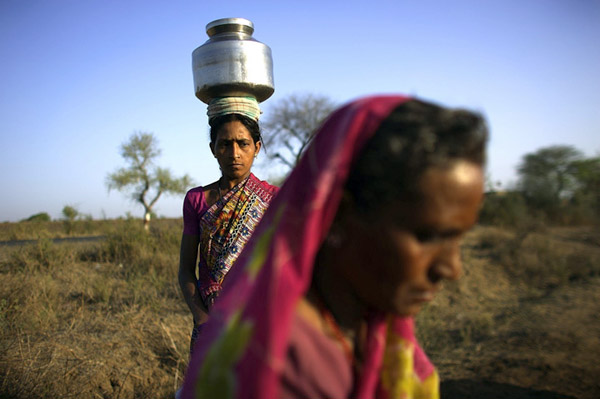
Collecting water. Amravati District, India 2010
Michael F McElroy (b. 1969 USA) is a photographer based in Miami, Florida. His photographs have been published in The New York Times, The Guardian, Revue, Monocle and Burn as well as other international magazines and newspapers. His work has been recognized by POYi, Communications Arts, Atlanta Photojournalism and the Society for News Design. He is currently working on a project documenting India’s water crisis. Michael is represented by Wonderful Machine and Zuma.
About the Photograph:
“Water has become the most commercial product of the 21st century. The stress on the multiple water resources is a result of rising population and changing lifestyles combined with intense competition among agriculture, industry and domestic users. For the women in India’s rural area’s getting a bucket of drinking water is a daily struggle in which most cases women walk an average of 2.5 kms to reach a source of water that is often contaminated with high levels of fluoride or is to saline to drink. Despite the installation of 3.5 million hand pumps and thousands of water projects, sources are drying up due the lower than average monsoon rains, leading to acute water scarcity. The end result of this lack of water in the rural areas is pushing villagers to move to the cities that are already bursting at the seams with people and facing there own water problems. As India’s population of 1.15 billion people grows by 18 million a year, the situation is only expected to worsen.”
Andy Spyra June 16, 2010
Posted by Geoffrey Hiller in India, Kashmir.Tags: India, Kashmir
comments closed
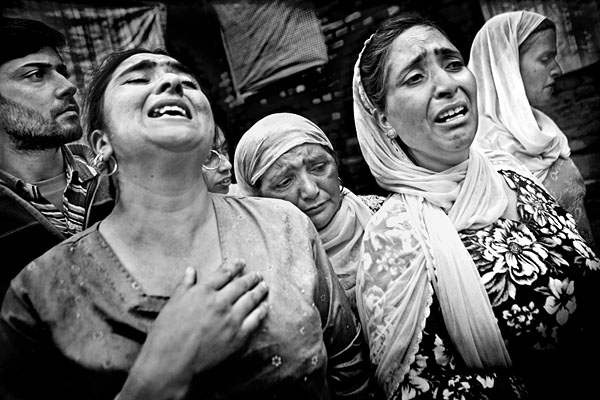
Srinagar, Kashmir 2008
Andy Spyra (born 1984, Germany) graduated from school in 2006 and following travels to Central America and SE Asia worked as a freelance photographer for a local newspaper in his hometown of Hagen, Germany. He later studied photography at the Fachhochschule in Hannover where he graduated in 2007. Andy has received grants and recognition from: Getty (Editorial Grant), Sony World Photography, POYl and PDN Emerging 30 (2010). His work has been published in Geo, Stern, One-Mag, Middle East Report, 360° Magazine, and Amnesty International. He is currently pursuing personal projects in the Balkans and the middle East.
About the Photograph:
“The photograph is part of my long term project on Kashmir. The people were mourning over the destruction of their houses by the local government, which claimed that the houses were build illegally on the shores of Dal lake and therefore had to be removed. The fact is, at the time of construction, no building permits or anything like that existed. As part of an ecologic campaign to save the rapidly shrinking and polluted Dal Lake the government is trying to move people away and resettle them somewhere in the countryside of Kashmir. Obviously most people don’t want to leave their homes voluntary so the government comes back with force and destroys the houses. Why this has to happen at the beginning of the long and cold Kashmiri winter is a question that remains unanswered.”

